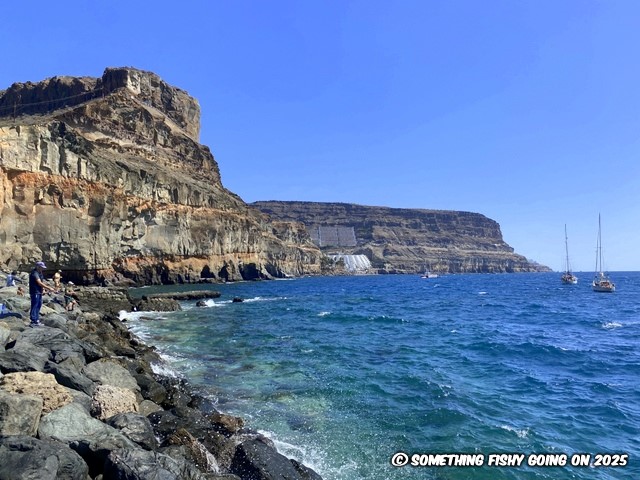Winter sucks. There's no getting away from the fact that the fishing locally is pretty hard going this time of year. It’s not that there aren’t any fish around, it’s just not much fun catching what is available in very cold, wet and also often windy conditions. Only dedicated cod anglers enjoy going out in such miserable conditions! Having only managed three fishing sessions since I returned from Asia in November, I decided I needed to get some winter sun, and after speaking to my mate Gordon, we decided to head down to the Canary Islands. I thought it would be interesting to split our trip across two islands, and after checking out ferry and flight options between the various constituents of the archipelago, we settled for Gran Canaria and Fuerteventura.
Minimal fishing tackle, at the ultra light end of the spectrum, was packed into my suitcase, and after arriving in Gran Canaria in the evening, we visited a supermarket to get some food for later on, as well as some bait in the form of a packet of frozen raw prawns. After reaching our accommodation and removing the required fishing gear from my suitcase, we jumped back into our hire car and headed to a spot nearby to open our account. We set ourselves what we felt was a fairly ambitious target of forty species for the week, and dropping small pieces of prawns on split shot rigs down the side at the end of Arinaga’s pier, we quickly caught our first few species of the trip.
 |
| There were lots of these Madeira rockfish out hunting after dark. Gordon also caught a solitary black scorpionfish. |
 |
| Gordon caught a nice dusky grouper that swam straight into a snag, but being patient and applying just the right amount of pressure, he managed to coax it out again. |
 |
| Casting further out onto cleaner ground, we both caught a few bastard grunt. |
Before we knew it a couple of hours had passed, it was quite late, and we were feeling quite hungry, so we called it a night and headed back to our accommodation for some tasty Spanish tapas, sliced meats, hard cheese, olives and tortilla all washed down with some red wine and few beers. A most pleasant end to our first few hours on holiday.
The following day, we headed to the southern side of the island. At our first stop, the main target was a Mozambique tilapia. There are lots of them in the coastal nature reserve in Maspalomas, in a body of water next to the sand dunes called La Charca. No fishing is allowed in there though, with lots of signs along the esplanade running alongside it making sure this is abundantly clear. Instead, we went to check out another body of water further inland, away from the coast. At this venue, there were also a few signs around the pond, but they didn't mention fishing!
 |
| Feeding the animals is not permitted. Not a problem. I brought some Gulp Angleworm! |
There were hundreds of Mozambique tilapia swimming around, so I knew straight away that catching them would be very easy. Using only a piece of line, a single split shot and the heavily scented worm like lure on a small hook, I quickly caught a couple of them, and then we headed off, just in case anything had been lost in my translation of the signs!
 |
| Rules circumvented with the aid of an artificial bait, I’d caught my first Mozambique tilapia and also my first new species of the trip! |
We then drove further west along the southern side of the island until we reached the village of Puerto de Mogan, where we made our way out onto the rocky breakwater of its golden sandy beach.
 |
| The busy resort of Puerto de Mogan. Fishing is permitted from the seaward side of Playa Mogan's relatively short rocky breakwater. |
 |
| The steep cliffs of the south coast of Gran Canaria are home to a few small villages and also large holiday resorts. |
There was a good depth of water in front of us, but our prawn chunks were being quickly stripped from our hooks. Often without any bites registering. This could mean only one thing. That there were lots of pufferfish around. Mainly Guinean puffer, with the odd Macaronesian sharpnose puffer in amongst them. Canary damsel fish were also abundant. These three species are super aggressive and are also adept at rapidly nibbling small pieces of prawn from a hook, meaning that other species which may be present in the area get caught much less often.
 |
| A Guinean puffer, by far the most common pufferfish we caught, and we caught lots of them! |
 |
| The prettier Macaronesian sharpnose puffer with its nice blue spots. An equally annoying bait stealer! |
 |
| Canary damselfish were also around in plentiful numbers. Their indigo markings are quite incredible, making them instantly recognisable. |
After a while, Gordon hooked into something that definitely wasn’t any of the three species above. I got the net ready and hopped down the rocks into a position to land whatever it was that had put a better bend in his rod. I had my suspicions about what it could be, but got a huge surprise when a red banded seabream appeared from the depths.
Hoping there were more around, we carried on fishing for a couple more hours, pulling in more of the other, less desirable species. After that we decided to head off to try another spot, but I knew before we left Gran Canaria that we’d have to return to have another session on Playa Mogan’s breakwater so I could try to catch a red banded seabream myself!
Tight lines, Scott.


No comments:
Post a Comment